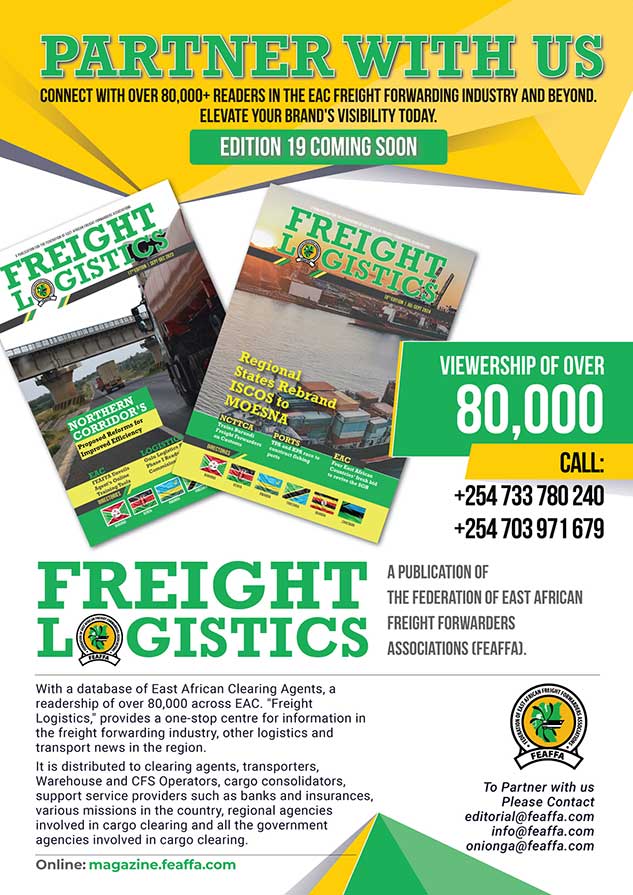Longer truck turnaround time around the Northern Corridor has increased the cost of transport of the empty containers, according to the Northern Corridor Transit Transport Coordination Authority (NCTTCA).
The COVID-19 pandemic has ravaged all sectors of the economy with measures, guidelines and protocols instituted by the East African region and individual Northern Corridor Member States to curb the spread of the Coronavirus disease.
The measures are partly seen to be contributing to delays in clearance and movement of cargo at both the port of Mombasa and along the Corridor. These delays have resulted in longer truck turnaround times to neighbouring countries.
“The empty freight transport trips have a particular impact on costs of doing business on importers who often incur additional charges in the form of penalties associated with delays in cargo clearance and return of empty containers,” NCTTCA said in a recent statement.
Although some measures were taken to ease the burden of costs associated with the delays in cargo clearance and return of empty containers by introducing the Through Bill of Lading (TBL), it has not achieved the envisaged results.
TBL enables importers to designate cargo directly to Nairobi or Naivasha Inland Container Depot (ICD). Although the government also extended the free period on return of empty containers from 45 days to 52 days and 14 days to 17 days for transit and domestic traffic respectively, road transport rates have been increasing.
Moving empty containers on Standard Gauge Railway (SGR) to designated yards has no extra costs to the importers and has no logistical nightmares for the shippers.
As a comparative illustration, road transport rates from the port of Mombasa to Bujumbura, Kigali and Goma are generally high, between 2.23 and 3.13 USD per Kilometre per container, whereas the transport rates from Dar es Salaam Port to those destinations are between 2.01 and 2.63 USD per kilometre per container. The transport rates from Mombasa to Nairobi and Juba are at 1.7 and 2.86 USD per kilometre per container, respectively.
The high transport costs along the Corridor may not only be attributed to empty return trips by trucks after offloading imports but also to other main factors including trade imbalance (imports and exports), non-harmonised road user charges, high visa costs from the region and inadequate infrastructure development hampering intra-regional trade among others, NCTTCA observed.
In an earlier interview, the Kenya Ship Agents Association (KSAA) said that there is a lack of understanding on the difference between a TBL and Merchant Haulage procedures for import cargo, which has a huge effect on the transport cost.
The contract on international carriage of goods by sea has set clear guidelines on where the obligations of the shipping line commences and ends. Through Bill of Lading refers to a single bill of lading covering receipt of the cargo at the point of origin for delivery to the ultimate consignee at a named place in the hinterland, Embakasi Internal Container Depot (ICD) or Naivasha ICD in case of Kenya’s SGR.
In the Merchant Haulage Containerized cargo, the responsibility of the Shipping Line ceases upon discharge of the container at the Port. This is the point where the consignee takes delivery of their goods and is given a time frame in which to return the empty container to the Shipping Line.
Hence, when the Shipping Line hands over the container cargo to the consignee at the port, the consignee will need to sign a ‘Guarantee Form’ – indicating where and when they will return the container to.
For those using TBL at the ICDs, the responsibility of returning the container to the shipping line is minimized. The importer will need to adhere to the rules set out in the ‘Guarantee Form’ that the shipping lines issues when it hands over the container and the cargo to the consignee at ICD.
The ‘Guarantee Form’ clearly indicates where and when they will return the container to and the numbers of days they have in which to honour this agreement.
It should be noted that this time frame in which they must return the container is costed by the Shipping Line and included in the freight rate offered to the client. Once the consignee exceeds the ‘free days’ allowed, then he is charged demurrage.
If the place of delivery on the ‘Guarantee Form’ is ICD, then upon delivery to that location, any storage accrued thereafter is on account of the shipping line.
In the Merchant Holding model, if the consignee returns the container at ICD yet the ‘Guarantee Form’ indicates ‘Mombasa empty depot’, then any storage time accrued by the empty container at ICD will be to the consignees account and not the Shipping Lines.
SGR, which is rapidly gaining importance as a transport solution for large cargo consignments destined for Kenya and the region has to some extent succeeded in convincing shippers to adopt the TBL freight model, especially for domestic cargo.





